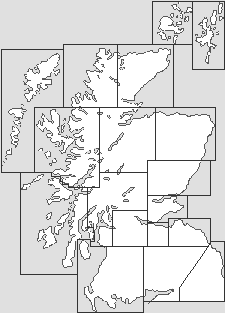 Peel of Lumphanan from the East, Showing the Access Path |
The Peel of Lumphanan is a defensive structure dating back to the early 1200s. It comprises a central mound measuring some 37m by 45m standing nearly 10m above an encircling moat or ditch. The moat is 15m wide, and is itself enclosed by an earth bank, some 4m high. The overall structure seems surprisingly complete and undisturbed, despite evidence of later use.
Macbeth was killed at the Battle of Lumphanan on 15 August 1057 and his story has long been linked with the Peel of Lumphanan.
But while Macbeth's stone, marking the spot where his head was severed, lies just 300m south-west of the Peel, and while a fortified motte very probably existed here at the time of his death, the Peel of Lumphanan itself dates back only to the years after 1230, when the de Lundin family were granted extensive landholdings in the area.
The de Lundins were the hereditary ushers or door-wards to the king, a role which later led to their adopting the family name of Durward. They erected their main castle at Coull, four miles to the west, while at Lumphanan they extended the existing motte and built an earthwork castle which would have been protected by a wooden palisade or a turf rampart around the outer edge of the central mound, and by the moat, which would have been filled by water diverted from the stream which passes the site. Within the palisade would have been a hall and a series of ancillary buildings.
If the Peel of Lumphanan arrived on the scene too late to witness the end of one Scottish King, Macbeth, it did form a staging post on the triumphal progress through Aberdeenshire of an all-conquering Edward I of England, who arrived here on 21 July 1296 to receive the surrender of a number of Scottish lords. The Peel seems to have fallen out of use after this event and, despite the obvious potential of its location, it never evolved into a stone castle, unlike so many other early defensive structures across Aberdeenshire.
The Peel came back into use in 1487, when Thomas Charteris of Kinfauns in Perthshire built Halton (or Ha'ton) House on the top of the mound. As manor houses go, this was a fairly modest one, and it seems to have fallen into disuse in the 1700s. All that remains of it today is a rectangular depression in the grass. In the 1800s a rectangular depression was excavated in the floor of the west side of the moat, surrounded by a low embankment. This was allowed to flood in winter and, when frozen, served as a curling pond.
 The Moat and Bank from the Mound |

|
|
|
Visitor InformationView Location on MapGrid Ref: NJ 576 037 www.historicenvironment.scot HES: Site Web Page Open all year and admission is free. What3Words Location: ///blogging.audibly.class |
 The Path Up the Central Mound |
 The Bank Outside the Moat |
 The Inside Face of the Bank |


